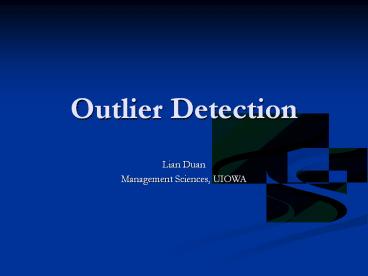Outlier Detection - PowerPoint PPT Presentation
Title:
Outlier Detection
Description:
Not all objects should belong to a certain cluster. ... Cluster A contains 296 benign records and 6 malignant records. ... Cluster-based outlier detection is ... – PowerPoint PPT presentation
Number of Views:362
Avg rating:3.0/5.0
Title: Outlier Detection
1
Outlier Detection
- Lian Duan
- Management Sciences, UIOWA
2
What are outliers?
- Hawkins-Outlier An outlier is an observation
that deviates so much from other observations as
to arouse suspicion that it is generated by a
different mechanism. - A relative concept
- Situation
- Your angle
- A example Suppose you are the US president.
- Common Thing Compare to History and Majority
3
Outlier Detection and Clustering
- Interwoven with each other.
- Not all objects should belong to a certain
cluster. - Abnormal events might have temporal or spatial
locality. (Body Temperature) - Single Point Outliers
Cluster-based Outleirs
4
Previous Work
- DB(pct,dmin)-Outlier Binary Given an object p,
at least percentage pct of the objects in D lies
greater than distance dmin from p. - Density-based local outlier Degree Given the
lowest acceptable bound of LOF, an object p in a
dataset D is a density-based local outlier if
LOF(p)gtLOFLB. - Other statistical methods.
5
Local Outlier Factor
- Local Density the inverse of the average
distance to its k-nearest neighbors. - Local Outlier Factor the ratio of the local
density of p and those of ps k-nearest
neighbors. - The LOF of each object depends on the density of
the cluster relative to it and the distance
between it and the cluster.
6
Illustration Of LOF
- A example
- LOF-Outlier vs. DB(pct,dmin)-Outlier
7
LDBSCANDBSCANLOF
- DBSCAN Retrieve all points which is
density-reachable from the given
Core-Point(MinPts, e). - Problem How many are many?
8
LDBSCAN (continued)
- A relative concept of core points and similarity.
- Core Points LOFltLOFUB
- Similarity p?NMinPts(q) and LRD(q)/(1pct)ltLRD(p)
ltLRD(q)(1pct)
9
LDBSCAN (continued)
- The same clustering idea with DBSCAN
- Parameter
- LOFUB
- pct
10
LDBSCAN (continued)
11
Advantage
- Density-based vs Partitioning Clustering
- Small clusters, arbitrary shape, and noise.
12
Advantage (continued)
- LDBSCAN vs DBSCAN
- Easier to select proper parameters.
- Handle local density problems.
13
Advantage (continued)
- LDBSCAN vs OPTICS
- Comet-like clusters
- Hierarchical structure
14
Performance
- Experiment facility P? 2.4G, 512M memory, redhat
9.0, jdk1.4.2 - Algorithm steps
- Search k-nearest neighbors O(n2) or O(nlogn)
- Calculate LRDs and LOFs O(n)
- Clustering O(n)
- Its compute complexity is
- equal to that of LOF.
15
Experiment
- Wisconsin Breast Cancer Data
- After data preprocessing, the resultant dataset
has 327 (57.8) benign records and 239 (42.2)
malignant records with nine attributes. - Discover two clusters and five single point
outliers. - Cluster A contains 296 benign records and 6
malignant records. Its average local density is
0.743. - Cluster B contains 26 benign records and 233
malignant records. Its average local density is
0.167. - Five single point outlier whose LOFs fall into
the range from 3 to 5.
16
Experiment (continued)
- Boston Housing Data
- After data preprocessing, the resultant dataset
has 506 records with 14 attributes. - Cluster (1, 82, 0.556) (2, 345, 0.528) (3, 26,
0.477) (4, 34, 0.266) (5, 9, 0.228) (6, 6,
0.127). - 4 single point outliers.
- Cluster 5 vs Cluster 6 (from cluster 1)
- 24.514 (bigger per capita cirme rate) vs 20.005
- 284th record (from cluster 4) LRD0.155,
LOF1.468. - 2nd attribute higher proportion of residential
land zoned for lots. - 3rd attribute lower proportion of non-retail
bussiness acres per town.
17
Appendix Cluster-based Outliers
- Definition 1 (Upper Bound of the Cluster-Based
Outlier) Let C1, ..., Ck be the clusters of the
database D discovered by LDBSCAN in the sequence
that C1C2Ck. Given parameters a, the
number of the objects in the cluster Ci is the
UBCBO if (C1C2Ci-1)Da and
(C1C2Ci-2)ltDa. - Definition 2 (Cluster-based outlier) Let C1,
..., Ck be the clusters of the database D
discovered by LDBSCAN. Cluster-based outliers are
the clusters in which the number of the objects
is no more than UBCBO. - Definition 3 (Cluster-based outlier factor) Let
C1 be a cluster-based outlier and C2 be the
nearest non-outlier cluster of C1. The
cluster-based outlier factor of C1 is defined as
18
Experiment (continued)
- Abnormal Network Throughput Detection
- Network throughput has the characteristic that
are consistent with self-similarity. - Monitoring 300 nodes per 5 minutes 3600 per hour
- Single point VS. Cluster-based
- 30 VS. 3 alerts per hour
- Occasional fluctuations VS. Abnormal events over
a period
19
Conclusion
- Outlier detection and clustering improve accuracy
with each other. - Cluster-based outlier detection is more
meaningful. - ADVERTISING LDBSCAN is good at both outlier
detection and clustering. - Clusters with arbitrary shape and different local
density - Single point outliers and cluster-based outliers
- Degree of outliers































